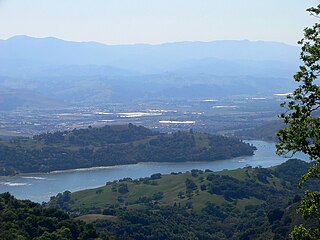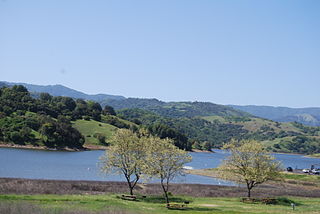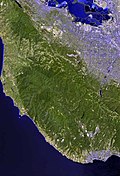
Almaden Valley, commonly known simply as Almaden, is a valley and neighborhood of San Jose, California, located in South San Jose. It is nestled between the Santa Cruz Mountains to the west and the Santa Teresa Hills to the east.

Santa Teresa is a neighborhood of San Jose, California, United States, located in South San Jose. Founded in 1834, Santa Teresa was originally established as Rancho Santa Teresa by the Bernal family, a prominent Californio clan. Today, Santa Teresa is largely a residential area, but also home to numerous Silicon Valley tech campuses.

The Diablo Range is a mountain range in the California Coast Ranges subdivision of the Pacific Coast Ranges in northern California, United States. It stretches from the eastern San Francisco Bay Area at its northern end to the Salinas Valley area at its southern end.

New Almaden, known in Spanish as Nueva Almadén, is a historic community and former mercury mine in the Capitancillos Hills of San Jose, California, located at the southwestern point of Almaden Valley in South San Jose. New Almaden is divided into two parts: the mines and much of their immediate surroundings, including historic ghost town settlements in the Capintancillas, which together form the Almaden Quicksilver County Park, and the largely residential historic district surrounding the Casa Grande.

Santa Teresa County Park is an 1,673-acre (6.77 km2) park in the Santa Teresa neighborhood of San Jose, California, located within the Santa Teresa Hills

Coyote Lake is an artificial lake in Santa Clara County, California, United States, between Morgan Hill and Gilroy.

Anderson Lake, also known as Anderson Reservoir, is an artificial lake in Morgan Hill, located in southern Santa Clara County, California. The reservoir is formed by the damming of Coyote Creek just below its confluence with Las Animas Creek. A 4,275-acre (1,730 ha) county park surrounds the reservoir and provides limited fishing, picnicking, and hiking activities. Although swimming is prohibited, boating, water-skiing, and jet-skiing are permitted in the reservoir.
José de los Reyes Berreyesa, also spelled Berrelleza, was born at Mission Santa Clara de Asís in Las Californias province of the Spanish Viceroyalty of New Spain.
Rancho Santa Teresa was a 9,647-acre (39.04 km2) Mexican land grant in present-day Santa Clara County, California given in 1834 by Governor José Figueroa to José Joaquín Bernal. The grant extended west from Coyote Creek to the Santa Teresa Hills, and included present-day Santa Teresa.
Rancho San Vicente was a 4,438-acre (17.96 km2) Mexican land grant in present-day Santa Clara County, California given in 1842 by Governor Juan Alvarado to José de los Reyes Berreyesa. The grant was located west of the Santa Teresa Hills at the south end of Almaden Valley. The grant was bounded on the north by Rancho Los Capitancillos.
Rancho Cañada de Pala was a 15,714-acre (63.59 km2) Mexican land grant in present-day Santa Clara County, California given in 1839 by Governor Juan B. Alvarado to José de Jesús Bernal. The origin of the name Cañada de Pala is the subject of debate. The word "pala" translates as "shovel" in Spanish, but means "water", in many Native Californian dialects. The grant was in the foothills and mountains of the Diablo Range, east of San Jose and included most of what is now Grant Ranch Park and all of present-day Blue Oak Ranch Reserve.

Almaden Reservoir is an artificial lake in the hills south of San Jose, California in the United States. It borders on the 4,163-acre (1,685 ha) Almaden Quicksilver County Park, which provides limited fishing ("catch-and-release"), picnicking, hiking, and horseback riding activities. Swimming and boating are not permitted in the reservoir.

Calero Reservoir, also called Calero Lake, is a reservoir in San Jose, California, located in the Calero neighborhood of Almaden Valley in South San Jose. It is the site of Calero County Park, which also includes a large area covering the lake and hundreds of acres of hills around it.

Tulare Hill is a prominent hill in the Santa Teresa Hills of western Santa Clara County, California. It lies along the southernmost edge of San Jose, California, adjacent to the Metcalf Energy Center. The hill and surrounding 330 acres (130 ha) of serpentine grasslands are home to the endangered Bay checkerspot butterfly and Dudleya setchellii wildflower. A portion of the hill makes up the Tulare Hill Ecological Preserve.

Guadalupe Creek is a 10.5 miles (16.9 km) northward-flowing stream originating just east of the peak of Mount Umunhum in Santa Clara County, California, United States. It courses along the northwestern border of Almaden Quicksilver County Park in the Cañada de los Capitancillos before joining Los Alamitos Creek after the latter exits Lake Almaden. This confluence forms the Guadalupe River mainstem, which in turn flows through San Jose and empties into south San Francisco Bay at Alviso Slough.

Alamitos Creek or Los Alamitos Creek is a 7.7-mile-long (12.4 km) creek in San Jose, California, which becomes the Guadalupe River when it exits Lake Almaden and joins Guadalupe Creek. Los Alamitos Creek is located in Almaden Valley and originates from the Los Capitancillos Ridge in the Santa Cruz Mountains, near New Almaden. This creek flows through the Valley's Guadalupe Watershed, which is owned by the Santa Clara Valley Water District. The creek flows in a generally northwesterly direction after rounding the Los Capitancillos Ridge and the town of New Almaden, in the southwest corner, before ambling along the Santa Teresa Hills on northeast side of the Almaden Valley. Its environment has some relatively undisturbed areas and considerable lengths of suburban residential character. Originally called Arroyo de los Alamitos, the creek's name is derived from "little poplar", "alamo" being the Spanish word for "poplar" or "cottonwood".

Santa Clara County Parks and Recreation Department, sometimes referred to as Santa Clara County Parks Department or Santa Clara County Parks, is a government department in Santa Clara County, California. The department manages 28 parks with a total area over 52,000 acres (21,000 ha).

Fisher Creek is a 13.8 miles (22.2 km) stream that flows northwesterly through the Coyote Valley in southern Santa Clara County, California, United States. It is a tributary to the largest freshwater wetland in Santa Clara County, Laguna Seca, a seasonal lake important to groundwater recharge. From Laguna Seca, Fisher Creek was connected to Coyote Creek by an artificial channel.

Communications Hill is a neighborhood located in the San Juan Bautista Hills of San Jose, California.

Calero, also known as Calero Lake and occasionally as South Almaden Valley, is a rural neighborhood in the Almaden Valley district of San Jose, California. Located in South San Jose, Calero is notably home to Calero County Park, which surrounds Calero Lake.






















